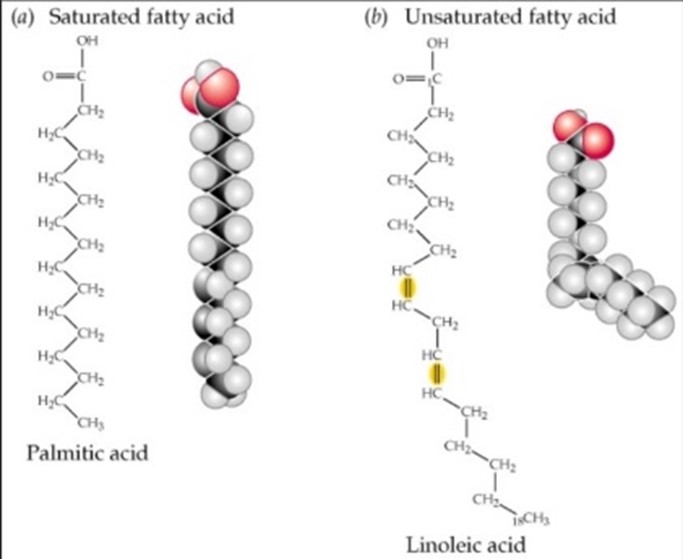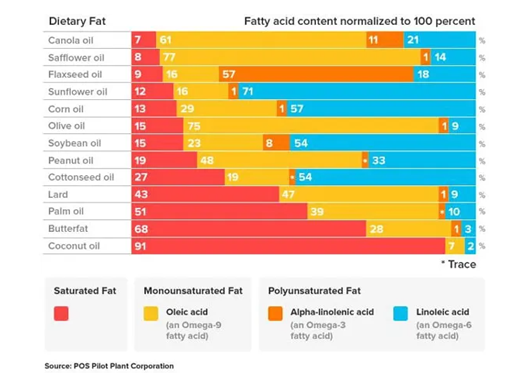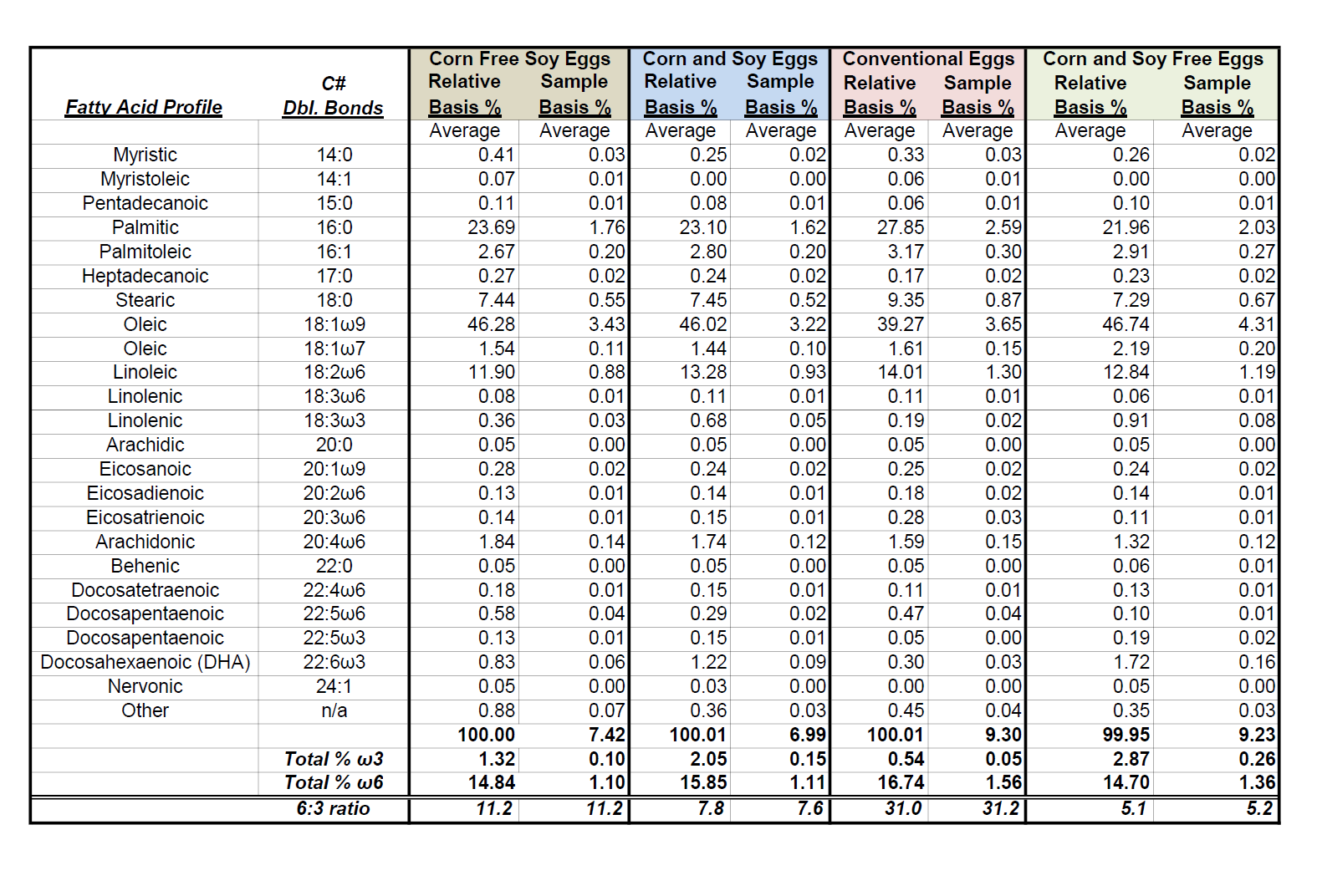Fats have received a lot of attention over the years from health experts. We hear them say butter is bad, use margarine, then margarine is bad, use seed oils, and now seed oils are bad, use butter. This article is not intended to chastise or promote any specific products but is an attempt to communicate an understanding of fats and fatty acids more clearly. Terms like fatty acid profiles, omega 3s and 6s, monosaturated fatty acids (MUFA), polyunsaturated fatty acids (PUFA) all sound important, but could also sound a little foreign. The first part of this article focuses on understanding fats, and the second part of the article focuses on relevance for the farmer.
Basic Functions of Fat
Fat is one of the three macronutrients that the body needs (protein and carbohydrates are the other two). Macronutrients make up the bulk of the human diet, contributing to structural and metabolic needs. Macronutrients are compounds that humans consume in large quantities to provide energy. Fat plays a vital role within the body in a variety of different ways.
- Fat is a source of energy.
- Fat helps with the absorption of fat-soluble vitamins like A, D, E, and K.
- Fat protects and helps the functioning of the grey cells within the brain.
- Fat is a structural component of all cell membranes (De Carvalho & Caramujo, 2018).
- Fat guards vital organs and acts as protection against sudden trauma.
Fat is a triglyceride, which has three fatty acid ester chains attached to the alcohol glycerol. Think of the letter E. The glycerol backbone has a fatty acid attached to each of the three arms of the letter E, shown in Figure 1.
Figure 1

(Kelly, n.d.)
What is a Fatty Acid?
Fatty acids makeup lipids (fats). A fatty acid has a straight chain of carbon atoms with hydrogen atoms along the length of the chain and a carboxyl group (-COOH) at the end. There are two types of fatty acids: saturated and unsaturated. Saturated fatty acids have single carbon to carbon bonds, and unsaturated fatty acids have at least one double carbon to carbon bond. Figure 2 shows examples of saturated and unsaturated structures. Saturated fats are typically solid at room temperature while unsaturated fats are typically liquid at room temperature (Rogers).
Figure 2

(Rabiya, 2019)
Fatty acids can be characterized as essential or non-essential.
- Essential fatty acids need to be consumed because the body cannot synthesize (make) them. There are two categories of essential fatty acids – omega 3 and omega 6. Numbers 3 and 6 refer to the position of the first carbon double bond in the fatty acid. Essential fatty acids are precursors to eicosanoids, which are hormones that control other hormones and body functions such as the central nervous system and immune system. Essential Fatty Acid deficiency is very rare in humans (Liu et al., 2017b)
- Non-essential fatty acids are made within the body. Non-essential fatty acids are still important, but do not have to be provided in the diet.
Each edible oil has a different fatty acid analysis, shown in Figure 3.
Figure 3

(Gunnars, 2023)
Saturated Fats, Monounsaturated Fats, and Polyunsaturated Fats
Saturated Fats
Saturated fats are solid at room temperature and can be found in animal products like butter, cheese, pork, beef, coconut oil, and lamb. Like many things related to human nutrition, the jury is still out on whether saturated fats are good or bad. The idea that saturated fats cause heart disease originated in the 1950’s. However, we now know that this theory is based on weak evidence and scientists have been unable to find a link between saturated fats and heart disease (Teicholz, 2022). In fact, a study done in 2020 found inconsistencies in the link between heart disease and saturated fats. Additional studies in 2010 and 2014 found no relationship between total saturated fat and risk of coronary heart disease. Studies comparing saturated fat to total carbohydrates have shown saturated fat to have similar associations with cardiovascular risk compared to total carbohydrate. Canada’s Heart and Stroke Foundation has recently removed any specific limitations on saturated fat, suggesting instead to focus on a “healthy balanced dietary pattern” (Liu et al., 2017).
Monounsaturated Fat
Monounsaturated fats (MUFA) have one unsaturated carbon bond and are typically liquid at room temperature. An example of monounsaturated fat would be olive oil (Monounsaturated Fats, 2023). This type of fat is not required in the diet, so the dietary guidelines for MUFAs are based on the difference of recommended saturated fat and polyunsaturated fat. Oleic acid is an example of a MUFA. Some of the benefits of oleic acid (omega 9) include:
- In 2018, the FDA released an update stating, “there is credible evidence to support a qualified health claim that consuming oleic acid in edible oils, such as olive oil, sunflower oil, or canola oil, may reduce the risk of coronary heart disease.”
- Oleic acid may be effective in the reduction of heart disease and cholesterol (Preedy & Watson, 2021).
- Oleic acid is stable and can enhance the activity of antioxidants (Sanders, 2015).
- Oleic acid makes up 55-83% of olive oil (Lopez et al., 2014).
Polyunsaturated Fats
Polyunsaturated fats include essential fatty acids. The health benefits of fatty acids continue to be studied, but some reports show potential benefits of certain fatty acids. For example, Omega 3 is an essential fatty acid. There are different types of Omega 3s, which include eicosapentaenoic acid (EPA) and docosahexaenoic acid (DHA), deriving from fish and algae products, and alpha linolenic acid (ALA), deriving from plants and animals. Several studies have been done which reveal the benefits of EPA and DHA on heart health. The information on ALA is less consistent, however studies suggest that it too is beneficial. Benefits of Omega 3 fatty acids include:
- Reducing the incidents of coronary heart disease (Fleming et al., 2014)
- Help with brain development and function (Satizabal et al., 2022) (Bourre et al., 2015).
Conjugated Linoleic Acid (CLA) is also known as Omega 6. CLA is another essential fatty acid. There have been claims that CLA can help eliminate cancer, prevent heart disease, and improve immune function; however, there are few human studies to indicate the truth of these claims (Dilzer, 2012). Large amounts of CLA in the diet can have a negative impact on health. Large quantities can cause insulin resistance, give rise to inflammation, and can lower good HDL Cholesterol.
Omega 6 to Omega 3 ratio
While the essential PUFAs are important individually, it seems the ratio of PUFA in a diet is more important than the fatty acids on their own. Due to the agricultural revolution, our diets have shifted from a hunter gatherer lifestyle to the current western lifestyle. Collective data shows that the western diet has an Omega 6 to Omega 3 ratio of 15:1-16.7:1. The western diet is high in energy and low in protein, creating a much higher omega 6:3 ratio. Experts suggest an Omega 6 to 3 ratio of 1:1 for optimal health. This ratio indicates that western diets are deficient in Omega 3 fatty acids while having excessive amounts of Omega 6. An imbalanced ratio increases chances for diseases such as inflammatory and autoimmune diseases, cancer, and cardiovascular disease (Simopoulos, 2008). These diet imbalances coupled with less physical activity lead to the increase of various diseases (Simopoulos, 2002).
Relevance for the farmer
The fatty acid profile of meat and eggs depends on two things: the animals’ digestive physiology and the feed the animal is consuming. Monogastric animals like pigs and poultry have a relatively simple digestive process. Because of this digestion, the fatty acid profile of what these animals consume transfers directly into their meat and eggs. Ruminant animals which include cattle, sheep and goats have a rumen that acts as a giant fermentation vat which “digests” feed (Butler, 2013). Ruminants don’t really digest in the rumen but rather the rumen ferments feed and then byproducts of the fermentation are absorbed and used by the animal. The fats consumed in a ruminant diet are hydrogenated in the rumen making them a saturated fatty acid. Due to this process, there are higher levels of saturated fatty acids in milk and meat from ruminants.
Diet has a direct impact on the fatty acid profile of pork, chicken, and eggs (Butler, 2013). So in theory, a better fatty acid profile feed will lead to a better fatty acid profile within the meat and eggs. If a hen consumes a diet high in Omega 3s, her eggs will be higher in Omega 3s compared to a hen fed a diet high in Omega 6s. Resaca Sun Feeds conducted a study to compare the fatty acid analysis of eggs from birds fed 3 different diets being raised on pasture and a 4th group from eggs raised in confinement. We had a total of four different sample groups: eggs from hens fed corn & high oleic soy feed on pasture (CS), eggs from hens fed corn & soy free feeds raised on pasture (CSF), hens fed corn free with high oleic soy on pastured (CF), and conventional store-bought eggs raised in confinement (CV). Each sample came from different farms throughout the southeast. Eggs for this trial were collected in April and May. The Omega 6 and 3 levels of the known feeds are shown in Table 1.
The results from this study are shown in Table 2. The lowest Omega 6:3 ratio is seen in the corn and soy free eggs at 5.2:1; however, corn and soy-based eggs weren’t far behind at 7.6:1. The highest Omega 6:3 ratio is at a whopping 31.2:1. That result is more than four times higher than corn and soy-based eggs raised on pasture. Another interesting observation, Corn and Soy Feed has nearly 10x higher Omega 6:3 ratio than the Corn and Soy Free Feed, but we do not see that drastic of a difference in the egg samples themselves. This is likely due to not having an equivalent comprehensive fatty acid analysis of the feeds as we do the eggs. While there is not a significant difference between CS and CSF eggs, there’s a substantial difference between eggs from hens raised on pasture and conventional storebought eggs.
Table 1: Omega 6 and 3 Levels of Feed

Table 2: Fatty Acid Analysis of Corn and Soy Free Eggs, Corn and Soy Eggs, Conventional Storebought Eggs and Corn and Soy Free Eggs

Summary
- Fat is one of the three macronutrients that the body needs.
- Fatty acids makeup lipids (fats). There are two types of fatty acids: saturated and unsaturated. There are both monounsaturated and polyunsaturated fats.
- Saturated fats are solid at room temperature and are found in animal products.
- Monounsaturated fats (MUFA) have one unsaturated carbon bond and are typically liquid at room temperature.
- Polyunsaturated fats have more than one unsaturated carbon bond and include essential fatty acids. Omega 6 and Omega 3 are essential fatty acids. The ratio of Omega 6 to Omega 3 in the diet is important.
- Diet has a direct impact on the fatty acid profile of pork, chicken, and eggs.
- Resaca Sun Feeds completed a study to compare the fatty acid analysis of eggs from chickens fed a variety of diets and raised on pasture compared to conventional, store-bought eggs. There’s a substantial difference between eggs from hens raised on pasture and conventional storebought eggs.
Citations
Axe, J. (2022). Linoleic Acid Can Help Improve Brain, Heart, Skin, Bone, and Reproductive Health. Dr. Axe. https://draxe.com/nutrition/linoleic-acid/
Barnes, J., Tappenden, K. (2017) Chapter 39 – Nutritional Management of Inflammatory Bowel Disease and Short Bowel Syndrome. Nutrition in the Prevention and Treatment of Disease (Fourth Edition). Pages 857-874. Academic Press. https://www.sciencedirect.com/science/article/pii/B9780128029282000394
Bourre, J., Dumont, O., Piciotti, M., Clément, M., Chaudière, J., Bonneil, M., Nalbone, G., Lafont, H., Pascal, G., & Durand, G. (2015). Essentiality of ?3 fatty acids for brain structure and function1. In World review of nutrition and dietetics (pp. 103–117). https://doi.org/10.1159/000419283
Butler, G. (2013). Manipulating dietary PUFA in animal feed: implications for human health. Proceedings of the Nutrition Society, 73(1), 87–95. https://doi.org/10.1017/s0029665113003790
Cherian, G., Holsonbake, T. B., & Goeger, M. P. (2002). Fatty acid composition and egg components of specialty eggs. Poultry Science, 81(1), 30–33. https://doi.org/10.1093/ps/81.1.30
De Carvalho, C., & Caramujo, M. (2018). The various roles of fatty acids. Molecules/Molecules Online/Molecules Annual, 23(10), 2583. https://doi.org/10.3390/molecules23102583
Dilzer A, Park Y. Implication of conjugated linoleic acid (CLA) in human health. Crit Rev Food Sci Nutr. 2012;52(6):488-513. doi: 10.1080/10408398.2010.501409. PMID: 22452730.
Fleming, Jennifer A., Kris-Etherton, Penny M. (2014). The Evidence for a-Linolenic Acid and Cardiovascular Disease Benefits: Comparisons with Eicosapentaenoic Acid and Docosahexaenoic Acid. American Society for Nutrition, 5, 8635-8765. https://www.ncbi.nlm.nih.gov/pmc/articles/PMC4224228/pdf/863S.pdf
Gunnars, Kris (2023). How to optimize your omega-6 to omega-3 ratio. Healthline. https://www.healthline.com/nutrition/optimize-omega-6-omega-3-ratio#TOC_TITLE_HDR_5
Kelly, J. (n.d.). 2.35 triglycerides | Nutrition. https://courses.lumenlearning.com/atd-herkimer-nutrition/chapter/2-35-triglycerides/
Liu, A., Ford, N. B., Hu, F. B., Zelman, K. M., Mozaffarian, D., & Kris-Etherton, P. M. (2017). A healthy approach to dietary fats: understanding the science and taking action to reduce consumer confusion. Nutrition Journal, 16(1). https://doi.org/10.1186/s12937-017-0271-4
Lopez, S., Bermudez, B., La Paz, S. M., Jaramillo, S., Varela, L. M., Ortega-Gomez, A., Abia, R., & Muriana, F. J. (2014). Membrane composition and dynamics: A target of bioactive virgin olive oil constituents. Biochimica Et Biophysica Acta – Biomembranes, 1838(6), 1638–1656. https://doi.org/10.1016/j.bbamem.2014.01.007
Monounsaturated fats. (2023, October 25). www.heart.org. https://www.heart.org/en/healthy-living/healthy-eating/eat-smart/fats/monounsaturated-fats#:~:text=What%20are%20monounsaturated%20fats%3F,oil%20that%20contains%20monounsaturated%20fats.
Nutrition, C. F. F. S. a. A. (2018, November 19). FDA completes review of qualified health claim petition for oleic acid and the risk of coronary heart disease. U.S. Food And Drug Administration. https://www.fda.gov/food/cfsan-constituent-updates/fda-completes-review-qualified-health-claim-petition-oleic-acid-and-risk-coronary-heart-disease
Preedy, V. R., & Watson, R. R. (2021). Olives and olive oil in health and disease prevention. In Elsevier eBooks. https://doi.org/10.1016/c2018-0-05075-6
Rabiya. (2019). Fatty Acid Structure | Examples | Types | Physical & Chemical Properties. iBiologia. https://ibiologia.com/fatty-acid-structure/
Rogers, K. (n.d.). Fatty acid. Encyclopædia Britannica. https://www.britannica.com/science/fatty-acid .
Sanders, T. (2015). Functional dietary lipids: Food Formulation, Consumer Issues and Innovation for Health. Woodhead Publishing.
Satizabal, C. L., Himali, J. J., Beiser, A., Vasan, R. S., Van Lent, D. M., Himali, D., Aparicio, H. J., Maillard, P., DeCarli, C., Harris, W. S., & Seshadri, S. (2022). Association of red blood cell omega-3 fatty acids with MRI markers and cognitive function in midlife. Neurology, 99(23). https://doi.org/10.1212/wnl.0000000000201296
Simopoulos, A. P. (2008). The importance of the Omega-6/Omega-3 fatty acid ratio in cardiovascular disease and other chronic diseases. Experimental Biology and Medicine, 233(6), 674–688. https://doi.org/10.3181/0711-mr-311
Teicholz, N. (2022). A short history of saturated fat: the making and unmaking of a scientific consensus. Current Opinion in Endocrinology, Diabetes and Obesity, 30(1), 65–71. https://doi.org/10.1097/med.0000000000000791
University of Hawai’i at Mānoa Food Science and Human Nutrition Program. (n.d.) Human Nutrition. Honolulu: University of Hawaii at Manoa.
